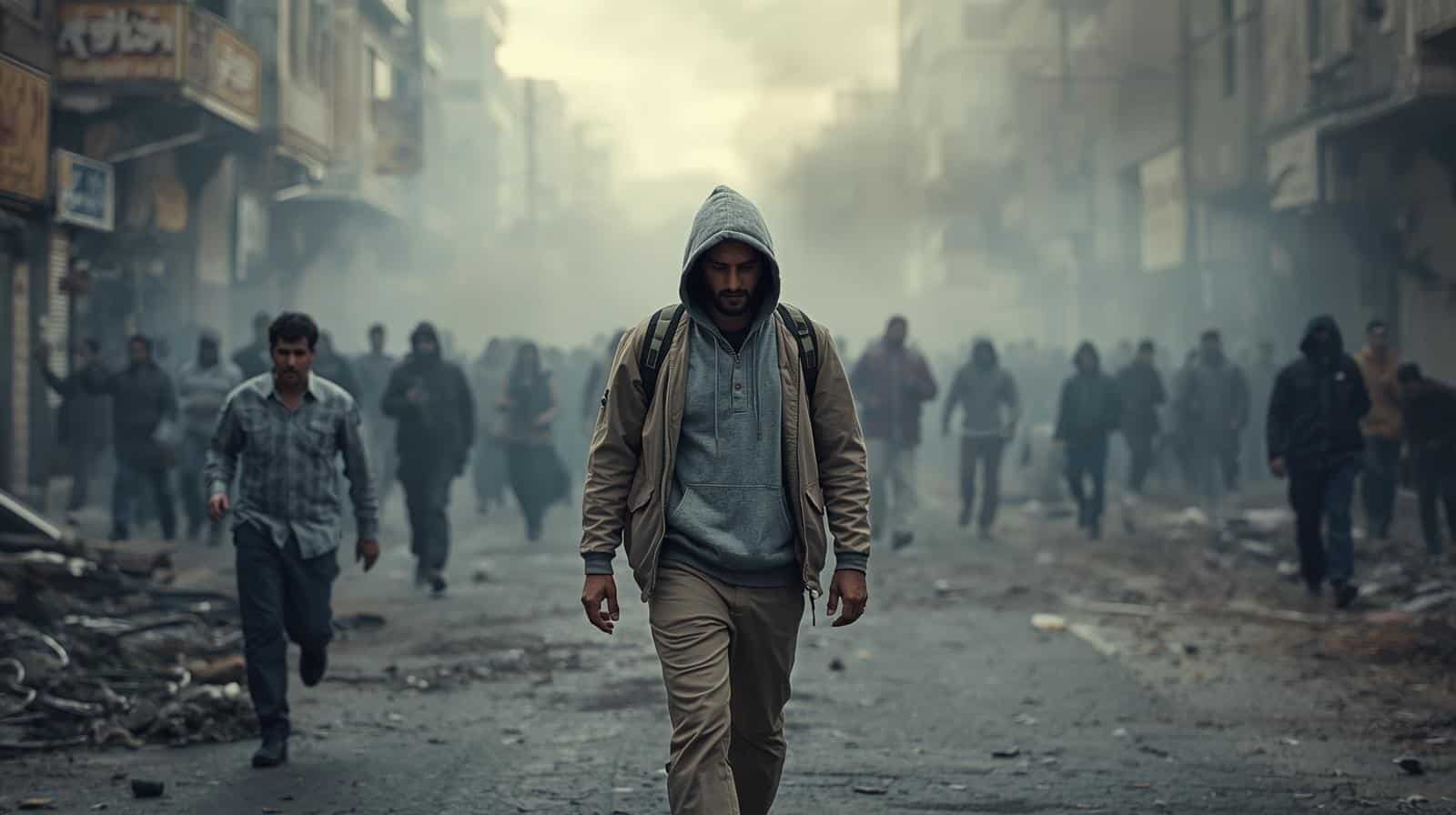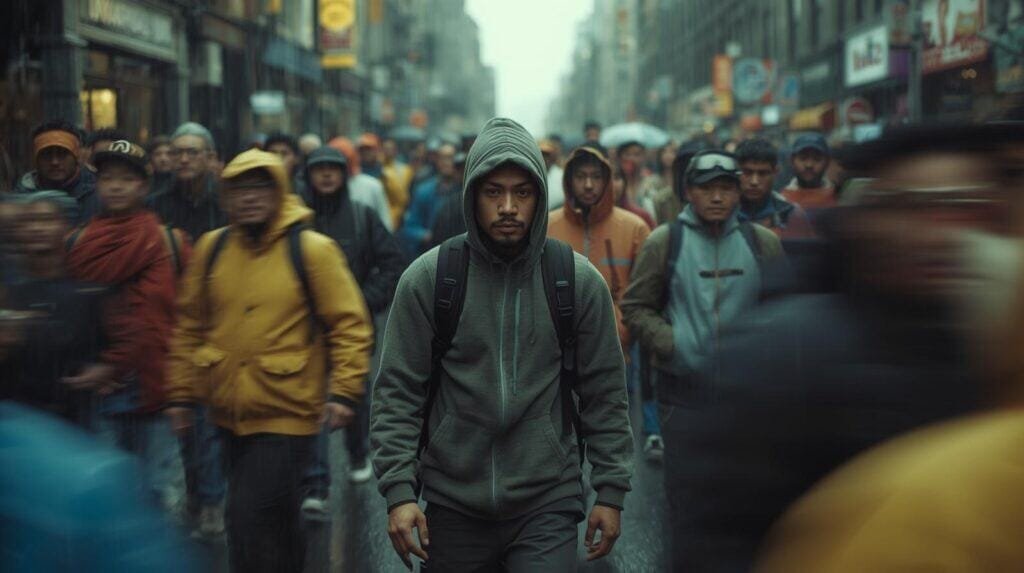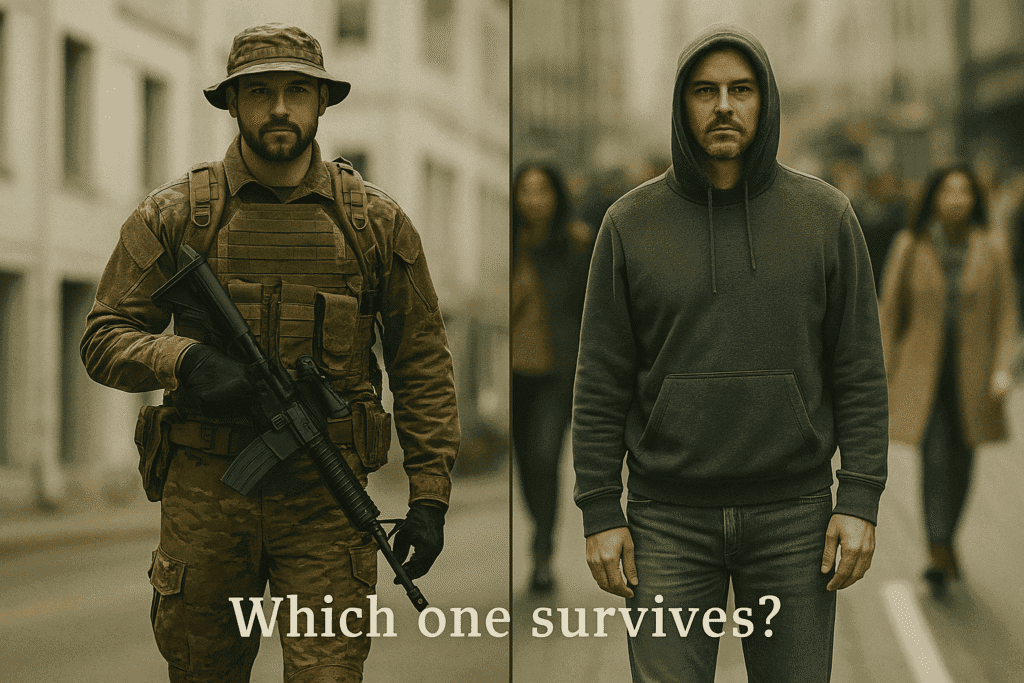
Gray Man Theory: Your First Line of Defense in SHTF Scenarios
The Prepper Paradox: Why Your Gear Might Get You Killed
You’ve spent thousands on freeze-dried food. Your bug-out bag weighs exactly 35 pounds, perfectly balanced. You’ve memorized every edible plant in your region and can start a fire in the rain. You’re ready for anything.
Except you’re not.
Because while you’ve been focused on beans, bullets, and Band-Aids, you’ve overlooked the single biggest threat in any survival scenario: other people. More specifically, becoming a target for other people.
This is where gray man theory enters the picture—and why it might be the most important survival skill you never practiced.
Most preppers obsess over their gear loadout but forget that in a real SHTF situation, looking prepared makes you a walking supply cache to desperate, unprepared people. Gray man theory is your first line of defense, the invisible shield that keeps threats from materializing in the first place. Before you draw your weapon, before you barricade your door, gray man theory keeps you off the radar entirely.
What Is Gray Man Theory?

Gray man theory is the practice of blending seamlessly into your environment to avoid drawing attention. The term comes from intelligence and executive protection communities, see also, situational awareness where operatives needed to move through hostile areas without being identified as threats—or targets.
The core principle is elegantly simple: the best fight is the one you never have.
In practical terms, gray man theory means you look, act, and move like everyone else around you. You’re not invisible—invisibility is impossible and trying too hard to disappear actually makes you more noticeable. Instead, you’re unremarkable. Forgettable. The person someone’s eyes pass over without a second thought.
Think of yourself as a background character in someone else’s story. You’re in the scene, but nobody remembers you were there.
Why Gray Man Theory Matters in SHTF Scenarios
Desperation Breeds Aggression
When disaster strikes, human behavior changes dramatically. The social contract that keeps most people civil dissolves remarkably quickly when children are hungry and stores are empty.
During Hurricane Katrina, we saw how fast “normal” people became looters. In the 2001 Argentine economic collapse, middle-class families resorted to home invasions to feed their children. When Venezuela’s economy imploded, armed gangs roamed neighborhoods looking for anyone who appeared to have resources.
Gray man theory recognizes this reality: in a crisis, people will take what they need from those who appear to have it. If you look like you’re prepared—if you’re wearing brand-new tactical gear, carrying an expensive pack, or moving with confident purpose while everyone else is confused—you’ve just painted a target on your back.
Standing Out Equals Becoming a Target
In SHTF scenarios, there are multiple types of threats:
- Desperate individuals looking for food, water, or supplies
- Organized gangs targeting those who appear to have resources worth taking
- Authorities conducting confiscations or forced evacuations
- Opportunistic criminals who see chaos as their chance
All of these threats have one thing in common: they select targets based on perceived value versus perceived risk. Gray man theory manipulates this calculation by making you appear to have nothing worth the risk of confrontation.
During the 1992 Los Angeles riots, businesses and homes that looked affluent or well-stocked were specifically targeted, while unremarkable buildings were often passed over. The rioters weren’t making random choices—they were selecting targets.
Resource Conservation
Every confrontation you avoid saves precious resources. A single fight could cost you:
- Ammunition (which you can’t replace)
- Medical supplies treating injuries
- Calories and hydration recovering from stress
- Time you could spend moving to safety
- The element of surprise if you need it later
- Potentially your life
Gray man theory is the ultimate force multiplier because it eliminates threats before they materialize. You’re not just avoiding one fight—you’re avoiding dozens of potential confrontations by never becoming a target in the first place.
What Gray Man Theory Is NOT
Before going further, let’s clear up some misconceptions:
Gray man theory is not about looking homeless or suspicious. A disheveled, nervous person actually draws more attention. Security personnel, police, and alert citizens all notice people who look out of place or threatening. You want to look normal, appropriate for your environment.
Gray man theory is not about being paranoid or antisocial. In daily life, being friendly and neighborly is part of good operational security. The person who never talks to anyone and avoids eye contact is memorable. The friendly neighbor who waves hello is forgotten five minutes later.
Gray man theory is not a replacement for other security measures. It’s layer one of your security onion. You still need physical security, weapons training, and defensive plans. But gray man theory keeps you from needing those other layers in most situations.
Gray man theory is not about being a victim. Some critics claim that gray man theory is passive or weak. They’re missing the point entirely. This is about tactical advantage. A special forces operator doesn’t walk into a hostile city wearing full kit and announcing their presence—they blend in, complete their mission, and leave without anyone knowing they were there. That’s not weakness; that’s professional competence.
The Three Levels of Gray Man Theory
Gray man theory operates on three distinct levels, each equally important:
1. Visual Gray Man
This is what most people think of first—how you look. Your clothing, gear, hygiene, and physical appearance all send signals about who you are and what you might have.
We’ll cover this extensively in the next article, but the key principle is matching your environment. In an urban evacuation, you don’t want to look like you just stepped out of a military surplus store. In a rural area during hunting season, wearing camo might actually help you blend in.
2. Behavioral Gray Man
How you move, where you look, your body language, and your actions all communicate information. Someone scanning rooftops and checking corners moves like someone with training. Someone walking with confident purpose when everyone else is confused looks like they know something others don’t.
Gray man theory at the behavioral level means moving like everyone else, matching the energy and tempo of your environment, and avoiding actions that signal you’re different.
3. Operational Gray Man
This is the most overlooked level: what people know about you before the crisis hits. If your neighbors know you’re a prepper, if you’ve posted photos of your gear room on social media, if you’ve told coworkers about your stockpile—you’ve already failed at gray man theory before SHTF.
When disaster strikes and your neighbor’s kids are hungry, where do you think they’re coming? To the person who bragged about having a year’s worth of food stored.
Common Mistakes That Blow Your Cover

Even well-intentioned preppers make critical errors that compromise gray man theory:
Tactical Gear in Civilian Contexts
That 5.11 Tactical jacket might be comfortable and functional, but everyone knows what it signals. Same with Molle-covered backpacks, plate carrier-shaped clothing, and anything in Multicam or coyote tan.
During an evacuation or crisis, showing up in full “operator” mode tells everyone: “I’m prepared, I have gear, I’m worth robbing.” You might as well wear a sign.
Gun-Related Branding
Glock hats, Sig Sauer patches, NRA stickers, “Come and Take It” shirts—all of these advertise that you likely own firearms. In a confiscation scenario, you’ve just identified yourself. In a looting scenario, you’ve advertised valuable items in your possession.
Gray man theory means keeping that information private.
Social Media Oversharing
Every photo of your gun collection, every post about your latest prep purchase, every check-in at the gun range—all of it creates a digital dossier that makes you a target. Former friends, distant relatives, old coworkers—they all remember when SHTF and they’re desperate.
The OPSEC (Operational Security) community has been warning preppers about this for years, but people keep posting their entire security setup on Instagram for likes.
Having New/Clean Gear When Everyone Else Is Struggling
Three days into a crisis, most people look rough. They’re wearing the same clothes, they’re dirty, they’re exhausted. If you show up looking fresh with clean clothes and new gear, you stand out dramatically.
Gray man theory sometimes means intentionally weathering your gear or accepting that you’ll look as rough as everyone else.
Moving With Purpose When Everyone Else Is Confused
In the critical first hours of any crisis, most people are paralyzed by indecision or moving aimlessly. If you’re moving with clear purpose and confidence, you signal that you knew this was coming and you’re prepared.
Sometimes applying gray man theory means slowing down, looking uncertain, or even asking directions you don’t need—all to avoid looking like you have a plan when others don’t.
The Gray Man Mindset: Situational Awareness Without Detection

The psychological aspect of gray man theory is perhaps its most challenging element. You need to maintain high situational awareness while not appearing to do so.
Awareness Without Obvious Scanning
Trained security personnel have a distinctive head movement pattern—they scan systematically, checking corners and potential threats. It’s visible from a hundred yards away.
Gray man theory requires developing peripheral awareness. You’re noticing everything, but your head movements are casual, natural. You might stop to tie your shoe while actually scanning behind you. You might “window shop” while really checking reflections for followers.
Confident But Unremarkable Body Language
There’s a sweet spot between victim body language (head down, shoulders hunched, uncertain movement) and aggressive/confident body language (chest out, direct eye contact, purposeful stride).
Gray man theory aims for the middle: casual confidence. You know where you’re going, but you’re not broadcasting importance. You make brief, friendly eye contact if it happens naturally, but you’re not staring anyone down or avoiding all eye contact.
Being Forgettable Is a Tactical Advantage
In executive protection, there’s a saying: “If you remember the security detail, they failed.” The same applies to gray man theory. If someone can describe you in detail an hour after seeing you, you’ve failed.
This means avoiding:
- Distinctive clothing or accessories
- Unusual hair colors or styles
- Visible tattoos or piercings in crisis situations
- Carrying distinctive or expensive gear
- Having animated conversations or drawing attention
Think “Background Character” Not “Invisible”
Trying too hard to be invisible makes you suspicious. Someone wearing all black, avoiding cameras, and ducking away from people draws more attention than someone who just looks normal.
Gray man theory is about being the person in every scene that nobody notices. You’re there, you’re present, you’re just not interesting enough to remember.
When Gray Man Theory Is Most Critical
While gray man theory has applications in daily life, there are specific scenarios where it becomes absolutely critical:
Evacuations and Bug-Out Situations
When you’re leaving your home during an evacuation, you’re vulnerable. You’re carrying supplies, you’re in unfamiliar territory, and you’re surrounded by other people—some desperate, some opportunistic.
Gray man theory during evacuations means:
- Packing gear in normal luggage, not tactical packs
- Traveling in an unremarkable vehicle
- Avoiding convoy situations with other prepared individuals
- Not stopping to help unless you can do so safely (harsh, but true)
- Blending with the flow of evacuees rather than taking obvious tactical routes
Supply Runs During Shortages
When stores are being emptied and supplies are scarce, being seen leaving a store with a cart full of supplies makes you a target in the parking lot.
Gray man theory for supply runs:
- Multiple smaller trips rather than one obvious supply run
- Unmarked boxes rather than branded product packaging
- Varying times and locations
- Leaving separately if with a group
- Having someone watch your vehicle from a distance
Civil Unrest or Breakdown of Law and Order
During riots, protests, or general lawlessness, anyone who appears to have resources or doesn’t belong to the dominant group becomes a target.
Studies of the 1992 LA Riots showed that victims were often selected based on appearance—those who looked like outsiders or those who appeared to have valuables.
Government Checkpoints or Confiscation Scenarios
In disaster scenarios, authorities sometimes establish checkpoints or conduct “welfare checks” that can turn into confiscations of supplies, weapons, or even forced evacuations.
Gray man theory at checkpoints means looking compliant, unremarkable, and not worth detailed inspection. You’re not hiding anything (visibly), you’re not nervous, you’re just another citizen trying to get by.
The Critical First 72 Hours of Any Crisis
The first three days after any major disaster are the most dangerous. This is when panic is highest, when supplies run out for the unprepared, and when social order is most fragile.
Gray man theory is your primary survival tool during this window. After 72 hours, people start organizing, authorities establish control, or the situation stabilizes into a new normal. But in those first three days, being forgettable might save your life.
Real-World Applications and Case Studies
Hurricane Katrina (2005)
One of the most documented SHTF scenarios in modern American history. Reports from survivors indicate that people with obviously new gear, clean clothes, or visible supplies were targeted by both desperate individuals and opportunistic criminals.
Survivors who successfully employed gray man theory principles reported:
- Wearing old, worn clothing despite having clean clothes available
- Carrying supplies in trash bags rather than backpacks
- Moving with the crowd rather than taking direct routes
- Avoiding the appearance of being well-fed when others were not
Argentine Economic Collapse (2001-2002)
Fernando “Ferfal” Aguirre, who survived Argentina’s economic collapse, wrote extensively about survival in urban collapse scenarios. He emphasized that looking poor and unremarkable was essential for survival.
Middle-class families who maintained appearances of wealth were specifically targeted for home invasions. Those who successfully employed gray man theory—looking as desperate as everyone else—were more likely to be passed over.
Modern Applications
You don’t need a total collapse to benefit from gray man theory. Recent events have shown its value:
- During supply chain disruptions in 2020-2021, people loading shopping carts with bulk purchases were followed to their cars
- During civil unrest in various cities, people who appeared to be counter-protesters or outsiders were specifically targeted
- After natural disasters, FEMA and other agencies have been known to confiscate supplies from those who appear “too prepared”
Integrating Gray Man Theory Into Your Preparedness Plan
Gray man theory shouldn’t be an afterthought—it should be integrated into every aspect of your preparedness:
Gear Selection
When buying gear, ask: “Does this help me blend in or stand out?” Choose function over tactical appearance. A normal-looking backpack with hidden features serves gray man theory better than a Molle-covered pack.
Vehicle Choice
Your bug-out vehicle shouldn’t scream “prepper.” A lifted truck with KC lights, a Punisher skull, and pro-gun stickers fails at gray man theory. An unremarkable sedan or minivan succeeds.
Communications Plan
If your family uses tactical terminology or has a elaborate communication system, others who overhear will know you’re prepared. Gray man theory extends to how you communicate.
Physical Fitness
Being obviously fit in a crisis can make you stand out—especially if you’re moving easily while others struggle. Conversely, being obviously unfit can make you appear weak. The gray man theory sweet spot is “normal.”
Training
Take training seriously, but don’t advertise it. The person wearing their tactical course shirts and posting range photos has abandoned gray man theory before SHTF.
Common Objections to Gray Man Theory
“I shouldn’t have to hide who I am”
You’re right—in normal times, you shouldn’t. But gray man theory isn’t about normal times. It’s about survival when things go wrong. Your pride isn’t worth your life.
“Bad guys will target me anyway”
Actually, no. Criminals and desperate people make cost-benefit calculations. If you don’t appear to have anything worth taking, and you don’t appear to be an easy target, you’re not selected. Gray man theory manipulates this selection process.
“I need my tactical gear for function”
Function is important, but ask yourself: is the tactical appearance necessary for the function? Usually, no. There are plenty of highly functional items that don’t scream “prepared survivalist.”
“I want to help others in a crisis”
Noble sentiment, but you can’t help anyone if you’re robbed or killed in the first 48 hours. Gray man theory keeps you safe so you can help from a position of strength, not vulnerability.
Threat Level vs. Gray Man Priority
| Situation | Gray Man Priority | Key Focus |
|---|---|---|
| Daily Life | Medium | Operational security, not advertising preps |
| Natural Disaster Warning | High | Blending during supply runs, evacuation prep |
| Active Crisis (0-72 hrs) | CRITICAL | Complete gray man—visual, behavioral, operational |
| Stabilized Crisis (72+ hrs) | High | Maintaining low profile, avoiding new attention |
| Recovery Phase | Medium | Gradually returning to normal while remaining aware |
Gray Man Failures vs. Consequences
| Gray Man Failure | Visibility Level | Likely Consequence |
|---|---|---|
| Tactical clothing/gear | High | Immediate target for robbery or confiscation |
| Gun-related branding | Medium-High | Targeted for weapons, known to authorities |
| New/clean gear in crisis | Medium | Stands out, appears to have resources |
| Confident movement in chaos | Medium | Appears to know something, worth following |
| Social media oversharing | Low (pre-crisis) | Known prep location, targeted when SHTF |
| Helping obviously/publicly | Medium | Marked as someone with resources to spare |
Conclusion: Your Most Important Prep Costs Nothing
You can spend thousands on freeze-dried food, but if everyone in your neighborhood knows you have it, you won’t keep it for a week after SHTF. You can have the best firearms and training, but if you look like a target, you’ll need to use them—and every confrontation is a roll of the dice.
Gray man theory is the ultimate force multiplier because it eliminates threats before they materialize. It’s not about being scared or paranoid—it’s about being smart and tactical. It’s about understanding human behavior and manipulating it to your advantage.
The best part? Gray man theory costs nothing. It doesn’t require special gear or expensive training. It requires only awareness, discipline, and the ability to set your ego aside when survival is on the line.
Every special operations unit in the world understands this principle. Intelligence operatives stake their lives on it. Executive protection professionals build careers on it. Now it’s time for the preparedness community to embrace gray man theory as the fundamental skill it is.
Your beans, bullets, and Band-Aids are important. But gray man theory—the ability to move through a crisis without becoming a target—might be the prep that actually keeps you alive to use them.
In our next article, we’ll dive deep into building a gray man theory-compliant wardrobe that balances functionality with forgettability. Because looking the part is where gray man theory begins—but as you now know, it’s only the beginning.
Ready to learn more about preparedness and survival strategies? Check out these resources:
Remember: The gray man is forgotten. The forgotten survive.
Stay safe, stay prepared, stay gray.






